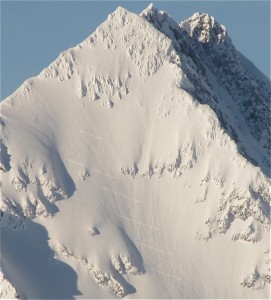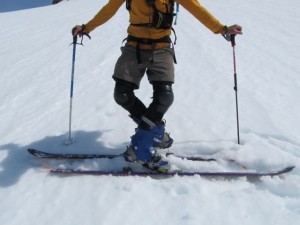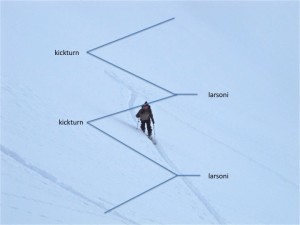On any given skin track there are subtle changes in angles that may indicate a good place to kickturn. The slope angle may leave us teetering on each turn due to deep snow or an obstacle. Some skiers may spend energy stomping out platforms to make it easier for those following to use the switchback area. Being skilled at a variety of kickturns increases efficiency and speed when traveling up through complicated and sometimes hazardous terrain.
The Larsoni
The “Larsoni,” or the downhill facing kickturn is one of the first skills taught to a beginner at a Nordic center, thus it may be difficult for those who have no experience in Nordic gear to appreciate this turn. It’s a turn I’ve seen humble some pretty accomplished skiers in their first attempt. The turn requires balance, flexibility and a willingness to learn something new.
The turn was later introduced at ski hills as a survival turn for alpine skiers and for the low angle cross-country tours with waxed skis. A growing interest in backcountry telemark skiing in the late 1970’s and 1980’s found the turn used for going up steeper hills. It was a way to swing a ski around on steep slopes because the telemark bindings at that time lacked the free pivot common today.
AT skiers can have a difficult time with the turn due to boot rigidity but can get the move down with practice. Splitboarders predictably struggle due for a variety of issues but I see no reason not to be able to do it in certain snow and terrain angles. Telemark boots are generally more flexible and thus better designed for the turn. If you are concerned about your knees, I would avoid this turn.
- As you approach your turn point, flatten out your skinning angle so you are at a right angle to the slope, and then stop.
- Place your poles behind you (uphill of your body) and pull the downhill ski up, and then flip it 180° and place it next to and below your other ski.
- This is the crux of the move as your skis are pointing opposite directions. It’s awkward at first so you have to move quickly before you lose your balance.
- Quickly lift and whip the other ski around and settle it slightly ahead of the other ski (ala telemark) and continue skinning uphill.
You need to hit the landing and keep your motion going forward and up!
Skinning followed by the rush of the downhill experience is an exciting experience for many of us. It’s not that hard to learn this skill with a bit of practice and keep you moving along on those endless switchbacks. Finally, there is not one true way to kick turn, like there is never one true way to ski.
Related Posts
Snap Kick-Turn on Steep Terrain
Step-down Kick-Turn
A-V-A Turn
© 2012




1 comment
As mentioned, the downhill kick-turn is also the turn of last resort when skiing down in stuff like heinous breakable crust. When I first started backcountry skiing it was with a Sierra Club group called the Alpine Ski Touring Committee. Their criteria for being allowed on a trip was the ability to climb whatever you ski, and demonstrated ability to ski down. Included in that latter requirement was the ability to do a downhill kick-turn. It was written in the by-laws.
Now that I have the benefit of a free pivot I don’t need it for uphill switchbacks, but I still use it on the down occasionally.